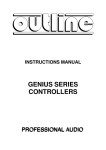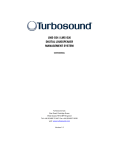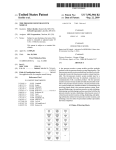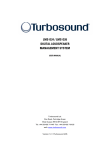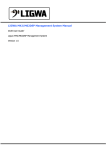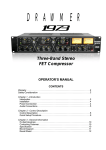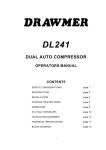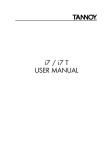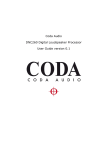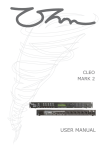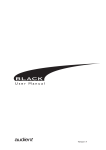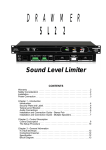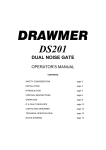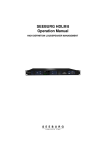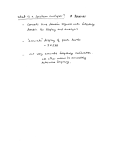Download cred MK2 manual 19-07-07.cdr
Transcript
CRED MARK 2 2-4 & 2-6 USER MANUAL USER MANUAL CRED MARK 2 The information contained within this manual does not include all of the details of design, production or variations of the equipment. Nor does it cover every possible situation that may arise during installation, operation or maintenance. If you need particular assistance beyond the scope of this manual please contact our technical staff. Magnetic Field - Caution CAUTION RISK OF ELECTRIC SHOCK DO NOT OPEN WARNING! RISK OF HAZARDOUS ENERGY! TO REDUCE RISK OF ELECTRIC SHOCK OR FIRE DO NOT EXPOSE TO RAIN OR MOISTURE. NO USER SERVICEABLE PARTS INSIDE. REFER SERVICING TO QUALIFIED SERVICE PERSONNEL. UNIT MUST BE EARTHED AND CORRECTLY FUSED. If an equipment rack is to be used, we would recommend mounting the amplifiers in the bottom of the rack and mounting pre-amplifier and other sensitive equipment such as the Cred Mk2 at the top of the rack. Do not locate sensitive high-gain equipment such as pre- amplifier or tape decks directly above or below amplifiers. Because amplifiers have a high power density there is a strong magnetic field which can induce hum into unshielded devices that are located nearby. The field is strongest just above and below the unit. The lightning bolt triangle is used to alert the user to the presence of un-insulated “dangerous voltage” within the unit that may constitute a risk of electric shock. CE Conformity The exclamation mark triangle is used to alert the user to important operating or maintenance instructions in the literature accompanying the product. Features This equipment has been tested and found to conform to the requirements of the EMC Directive 89/336/EEC, the requirements of the Low Voltage Directive 73/23/EEC, amended by 93/68/EEC and to the following standards: EMC Emission EN55103-1 (1996) EMC Immunity EN55103-2 (1996) Electrical Safety EN60065 (1998) ! ! ! ! Linea Research minimal signal path design Sonically superb ADC/DAC combination; a carefully matched pairing of the best devices from Burr Brown and Wolfson Newly released family of Analogue Devices SHARC DSP Extended bandwidth; 96kHz sampling frequency provides for a nominally flat response to 40kHz. Wellington Close • Parkgate • Knutsford Cheshire • WA16 8XL • England Tel: +44 (0)1565 654641 • Fax: +44 (0)1565 755641 Email: [email protected] • Website: www.ohm.co.uk 2 CRED Mark 2 2-4/2-6 Quick Reference Guide 5 Display 5 Channel Select Buttons Edit Select Buttons Parameter Knobs Mute Buttons Store Buttons Recall Button 5 5 5 5 5 5 The User Guide Front Panel Input Signal Indicators 6 6 Preset Store and Recall Channel Select Buttons Edit Select Buttons Text Display 6 6 6 6 Parameter Knobs Output Signal and Limiter Indication 6 7 Mute Buttons and Status LED’s Secure Button (on the Rear) 7 7 Rear Panel Power Inlet Network Expansion Port 8 8 8 Audio Input Connectors 8 Output Connectors 8 Communications Port Connector 8 9 Operation Starting Up 9 Selecting a Factory Preset 9 Creating a Crossover 9 Navigation and Viewing Parameters 9 Navigation 10 Preset Store and Recall Preset Recall Preset Store Output DSP block diagram 10 10 11 12 Stereo / Mono Formats DSP processin 12 13 Input Channels 13 Output Channels 15 Utilities Factory Presets 17 18 EQ and Filter Response Graphs 19 Technical Specification 20 General Processing 20 20 Connectors 20 3 INTRODUCTION Congratulations on having purchased an OHM CRED Mark 2 Please read this manual and familiarize yourself with the operation of your OHM CRED Mark 2 before you attempt to power up the unit. For your own safety we recommend you take the time to read all the warnings and precautions on the page opposite and study the connection details to ensure correct usage and avoid any misuse which may invalidate your warranty. Record the serial number, found on the back of the unit, in the spaces designated on the warranty card, and in the space provided below. Refer to the model and serial numbers whenever you call your dealer for information or service on this product. Model Serial Number The OHM CRED mark 2 series of loudspeaker management systems represent the current state-ofthe-art. Taking advantages of the latest advances in analogue to digital conversion and digital signal processing technologies the units achieve performance levels that have only recently been made possible. This modern design is combined with OHM Factory Presets to deliver the optimal match for OHM cabinets and systems. These presets allow the user to simply achieve the best possible Unpacking Carefully open the shipping carton and check for any noticeable damage. Every OHM CRED Mark 2 has been rigorously tested and inspected before being carefully packaged, prior to shipping. If any damage has occurred to the packaging or the unit during transit, please notify the delivery company as soon as possible. Only the consignee can file a claim against the carrier for shipping damage. Be sure to save the carton and all packing materials for the carriers inspection. We recommend that you retain the original carton and packing materials for use should you transport or ship the unit in future. Precautions ! ! ! ! ! ! ! ! ! ! 4 Retain this manual for future reference. Do not stand the unit vertically on it’s rear. Always check the correctly rated power is supplied to your unit. Avoid direct contact of your CRED with water or other liquids. Do not operate while standing in liquid. When cleaning the unit, wipe with a soft, dry cloth. If more heavy duty cleaning is required, disconnect from the mains and use a damp cloth, ensuring the unit is completely dry before reconnecting to the mains. Do not use solvents or chemicals on the exterior of the unit as they cause the surface to discolour or peel. Do not use if the power cord is frayed or broken. If you experience continuous problems disconnect from the mains and refer to a qualified service engineer. This unit is only intended for qualified personnel to operate and install. Do not attempt to repair or service yourself. Please refer to qualified technical service department. The user must have sufficent electrical contact to earth. Electrostatic charges may effect the operation of the CRED. CRED Mark 2 2-4/2-6 Quick Reference Display The LCD Displays preset and parameter information. The default screen is shown after start up and displays the number of the current preset on the lower line of text. When navigating around the adjustable parameters, other information is shown. Channel Select Buttons The currently selected input or output channel is shown in the top left corner of the display. Pressing the channel select buttons scrolls through the available inputs and outputs. If operating stereo linked the channel pair is shown. For example ‘CH A+B’ means both input A and B parameters. Edit Select Buttons The name of the edit parameter page is displayed in the bottom left portion of the LCD. Pressing the edit select buttons moves through the available parameter pages for the current input or output. Parameter Knobs Up to three parameters are shown on the display. The parameter name is shown with its' current value below. Where appropriate, parameters are grouped according to function. For example the parametric equalisation page shows centre frequency, width and gain. Turning a parameter knob clockwise will increase the value of a parameter, turning anti-clockwise will decrease it. Turning a knob rapidly will cause the action to 'accelerate', so the value changes more rapidly. Mute Buttons The LEDs next to the mute buttons indicate their current status. Pressing a mute button toggles between the mute on and off. Store Button The unit has 45 preset locations. To store a preset in a location, press the store button and use the parameter knobs to select the preset location and name the preset. Pressing the store button again completes the task. Pressing any button other than store during the process cancels the procedure. Recall Button To recall a preset, press the recall button and use parameter knob A to select the required preset. Pressing the recall button again will activate the preset. You will then be asked to confirm by pressing recall once more. As with the store function, pressing any button other will cancel the process. 5 Front Panel 1 2 3 4 5 7 7 7 7 7 7 6 6 6 8 8 8 8 8 8 1 Input Signal Indicators A set of three pairs of LEDs indicate signal present, +4dBu and input clip for each channel. The signal present LEDs operate at approximately 40 dBu, giving a useful indication of even relatively low input signal levels. The +4 dBu LEDs are intended to show nominal operating level and can also be useful for setting system gain structure. Clip LEDs warn the user of input overload and operate at +19 dBu. 2 Preset Store and Recall These controls provide access to the 45 presets stored within the device. Pressing the store button allows the user to name a preset and choose which memory location it will be held in. Pressing store button again completes the process. The Recall function operates in a similar way, pressing the recall button allows the user to select which preset they require, pressing the button for a second time, then confirming, recalls the new DSP settings. Note that presets cannot be stored or recalled when Secure mode is activated. 3 Channel Select Buttons The currently selected channel is displayed on the top left hand corner of the LCD. Pressing the channel buttons scrolls through the available input and output channels and finally through the utility functions and back to the default screen. If operating a stereo linked preset, the channel name will indicate the channel pairing. For example 'A+B' means both input A and B parameters. The name of the output will be shown briefly at the top of the display when stepping onto an output. 4 Edit Select Buttons The currently selected edit parameter page is displayed on the bottom left corner of the LCD. Pressing the edit select buttons moves through the available parameters for the current input or output. 5 Text Display Preset, channel, parameter and status information is shown on the 2x 24-character text display. In most screens the currently selected channel is displayed on the upper line and the edit parameter on the lower line. To simplify the display and enhance security, some parameters or parameter pages are omitted when not relevant. 6 Parameter Knobs Three velocity sensitive parameter knobs are used to adjust parameters shown on the display. Up to three parameters at a time are displayed on the screen. The parameter name is shown above the parameter value in each of the three screen sections. The parameter knobs have a fixed association with the screen sections; the rightmost parameter knob adjusts the rightmost parameter and so on. 6 CRED Mark 2 2-4/2-6 1 2 3 5 4 7 7 7 7 6 6 6 8 8 8 8 7 Output Signal / Limiter Indication Two LEDs are provided for each output channel. These show the signal level relative to the limiter threshold. The yellow LED will light when the signal is 6dB below the threshold and the red 8 Mute Buttons and Status LEDs Each output has a mute button and associated status LED. Pressing the button toggles the mute on and off. Note that the mute buttons do not function when the Secure mode is activated. 9 Secure Button (on the rear) A momentary button is fitted behind the rear panel, between the output XLRs and the RS232 port. When activated, this will disable all the front panel controls so they cannot affect the signal path, making the unit secure against tampering. When in secure mode, the indicators still operate normally. Note that the communications port is still active in secure mode. 7 Rear Panel 1 1 2 2 5 5 9 4 9 4 4 4 4 4 4 4 4 4 3 3 PUSH PUSH PUSH PUSH 3 3 1 Power Inlet The OHM CRED series unit should be connected to a suitable mains electricity supply using the cable supplied. The processor has a switch mode power supply that is capable of operating with a nominal mains voltage of 85V to 240V, 50/60Hz without re-configuration. 2 Network Expansion Port This allows for a network card to be fitted. 3 Audio Input Connectors All audio connections are fully balanced and wired pin-1 ground, pin-2 hot & pin-3 cold. The two inputs have pin-1 connected directly to the chassis and feed the signal processing chains. If an unbalanced source is used, a connection should be made between the pin-3 'cold' signal and the 4 Audio Output Connectors The processed outputs are impedance balanced, and wired pin-1 ground, pin-2 hot and pin-3 cold. An unbalanced input may be driven by connecting pin-3 'cold' signal to the ground connection of the unbalanced destination input. Note that output pin-1's are ground lifted at audio frequencies but connected to ground at RF for good EMC performance. The intention being that the amplifiers the processor is driving should be responsible for the grounding of their input cable shields. 5 Communications Port Connector A CRED processor may be controlled entirely from another controller, typically a Personal Computer, running an application that is compliant with the ObCom standard. Connection will normally be made to the controller via this serial port connector. This port is also used for updating the firmware in the unit. Note that the communications port is NOT disabled when the front panel is made secure using the secure button. 8 CRED Mark 2 2-4/2-6 Operation Starting up The unit will energise as soon as power is applied to the IEC inlet; there is no power switch. During the start up process the firmware application model number and version numbers are displayed and the outputs are muted until the unit has completed its internal checks. Once the start-up routines are complete and the unit is ready to pass audio. The DSP signal path will be restored to the current settings when it was last powered down and the audio signal is gradually ramped up to its correct level. Selecting a Factory Preset The CRED series processors have a library of Factory Presets designed to suit a range of OHM enclosures. Factory Presets contain some parameters that are fixed and hidden from view; the remainder of the DSP parameters are available for user manipulation. The number and type of hidden parameters is dependant on the Factory Preset, typically crossover frequencies, output delay and some EQ's are hidden; those settings that are a function of the loudspeaker cabinet design and should not require adjustment for different applications. To recall a Factory Preset for a particular cabinet or system, press Recall and use the left hand parameter knob A to scroll through the available factory preset locations (as indicated by a box symbol after the preset number). Once the appropriate preset has been selected press recall again, at which point you will be asked to confirm the action by pressing recall for a third time. This is to guard against accidental recall of Presets. Factory Presets are locked so they cannot be over-written. The user can, however, store an edited version of a Factory Preset in any free preset location. Details of all the Factory Presets including output designations can be found in Appendix A. Creating a Crossover In addition to the Factory Presets the unit has two further 'Base Presets'; mono and stereo. These Base Presets are stored in locations 1 and 2 respectively, they can be used to develop settings for any loudspeaker combination and are recalled in the same way as the Factory Presets described above. These Presets are also locked but the user can name and store their own edited versions in any free preset location. Navigation and Viewing Parameters Many of the processing elements in each input and output path have features that may be controlled by the user, such as gain, frequency or limiter threshold. We call these adjustable features parameters In A Freq EQ1 100Hz Slope 12dB A A B B Gain 0.0dB C C 9 3 A parameter may be adjusted when it is displayed by turning one of the three-parameter knobs. Each of the three-parameter knobs is associated with a zone on the display. Adjusting the leftmost parameter knob will change the value of the parameter showing in the leftmost zone of the display and so on. Turn a knob clockwise to increase the value of a parameter, or anti-clockwise to decrease it. The knobs are velocity-sensitive so turning a knob rapidly will cause the action to 'accelerate', so the value changes more rapidly. Navigation The DSP parameters are organised by channel. The currently selected channel is shown in the top left hand corner of the display. You can navigate between the channels by pressing the channel buttons. Pressing the channel buttons will scroll through the channels, utilities and back to the default screen. When using a Preset that is stereo linked, the channel selection will reflect this. For example '1&4' indicates outputs 1 and 4. When navigating onto an output channel, the usage of the output, as define in the factory preset, will be shown briefly at the top of the screen. CHANNEL Out1 Freq EQ1 100Hz A Width 1.4Q B Gain 0.0dB C PARAMETER Pressing the edit navigation buttons gives access to the various pages of parameters available for each channel. The currently selected page is shown in the bottom left hand corner of the display, this is omitted on some pages where the function is obvious. The screen shows up to three (normally related) parameters for a given part of the processing functions on a given channel. The edit buttons allow you to scroll, in either direction, through the different processing pages for a given Channel. When you go past the last page, you will be returned to the default page. The channel buttons allow you to scroll, in either direction, through the input and output channels, whilst trying to maintain the currently viewed processing block. If the channel you scroll to does not have the currently viewed processing block, the next one will be shown instead. NB. When the unit powers-up, the settings will be the same as those when the unit was last switched off. Presets The device contains a total of 45 user and Factory Presets. The user cannot overwrite the basic mono, basic stereo or Factory Preset programs. Preset Recall To select an existing Preset, press the Recall Button so the indicator above it illuminates. Turn parameter knob A until the required Preset number is shown on the display. Factory presets are indicated by a box symbol appearing after the preset number. Press the Recall Button again to activate the Preset. Pressing any other button will cancel the operation. 10 CRED Mark 2 2-4/2-6 Preset Name Recall 32 My System A B Recall C Recall A SELECT PRESET TO RECALL Users can develop their own Preset based on one of the basic or Factory Presets stored within the device. Once a basic or user Preset has been recalled, a user has complete freedom to adjust any or all of the parameters. Factory Presets can be used as the basis for user Presets but they have some parameters that are predefined as a function of the loudspeaker system. These parameters are 'hidden' from the user, as they should be constant regardless of application. Preset Store To store the current Preset in a user location, press the Preset Store Button so the indicator above it illuminates. Turn the first parameter knob until the required Preset location number is show on the display. A Preset name of up to 12 characters in length can be entered using parameter knobs B and C. Pressing the Store Button again completes the process and stores the Preset. As with Preset Recall, pressing any other button cancels the operation. Preset Name Recall 32 My System A B C SELECT STORE LOCATION Store Store A B NAME PRESET C The user can overwrite non-protected Presets only; if an attempt is made to save a Preset in a location already occupied by a basic or Factory Preset a 'LOCKED PRESET' message is displayed. 11 DSP Processing layout Input DSP block diagram Input A Input LED’s Input Gain Delay 4th Order HPF Low Shelf EQ Six Band PEQ High Shelf EQ Routing Sum -6dB Input B NB. Channel B processing is Identical to Channel A but for clarity it is not shown Output DSP block diagram Delay 8th Order HPF th 8 Order LPF Low Shelf EQ Six Band PEQ High Shelf EQ Output Gain Mute Limiter Routing Metering Routing Stereo / Mono Formats Stereo / Mono Formats There is only one 'standard' layout of the processing blocks, but flexible routing and control linking allows this layout to be adapted to a wide variety of applications. There are two 'Formats', Mono or Stereo. With the Mono format, all outputs have unique parameter settings, and all outputs are identical in terms of processing functions and routing capability. This is the most flexible Format. Stereo format pairs the inputs and outputs for stereo operation, the parameters of each member of the pair being identical. The routing of inputs to outputs is fixed. This format is intended for symmetrical stereo operation, eliminating the need to make identical parameter adjustments for each channel. The channel pairing is: ! Left and Right Inputs ! Outputs 1 (routed from L input) and 3 (routed from R input) [1 and 4 for CRED 2-6] ! Outputs 2 (routed from L input) and 4 (routed from R input) [2 and 5 for CRED 2-6] ! [Outputs 3 (routed from L input) and 6 (routed from R input) - CRED 2-6 only] 12 CRED Mark 2 2-4/2-6 DSP processing Input Channels Gain In A Gain 0.0dB A B C A ! Knob A: Gain, adjustable in 0.2dB steps from -80dB to +20dB Delay In A Delay 1.50ms A B C A ! Knob A: Delay, adjustable in variable steps from 0 to 400ms The delay parameter is adjustable in fine steps at low values; the adjustment becomes progressively coarser as the value increases. The velocity sensitive Parameter Knobs therefore provide accurate setting of driver offset delays (typically below 10ms) and rapid setting of longer system alignment delays. High Pass Filter In A HPF Freq Shape 20.0Hz LR24 A A B C B ! Knob A: Gain, adjustable in 0.2dB steps from -80dB to +20dB ! Knob B: High Pass Filter type 13 3 System high pass filtering is provided for the input signal. This is the preferred location for high pass filtering as it affects all outputs and can therefore improve inter-band phase relationships. Filter type is selectable from Butterworth, Bessel, Linkwitz-Riley and Hardman. Filter slopes of up to 4th order or 24dB / octave are provided. Not all filter types are available in all slopes. For example 18dB / octave Linkwitz-Riley filters do not exist. The Hardman type filter is always described by its' order as the filter becomes progressively steeper rather than following a linear slope so a dB/octave description is not accurate. Parametric Equalisation Eight sections of equalisation are provided, two shelving filters and six fully variable parametric sections. define in the factory preset, will be shown briefly at the top of the screen. High and Low shelving filters In A Freq EQ1 100Hz Slope 12dB A B Gain 0.0dB C B A C ! Knob A: Frequency, 10.0Hz to 25.6kHz in variable steps ! Knob B: Slope, 6 to 12dB / octave in 1dB steps ! Knob C: Gain, +/-15dB in 0.2dB steps The frequency is specified as point where the filter deviates by 3dB from the gain value. Parametric Filters In A Freq EQ1 100Hz Slope 1.4q A A B Gain 0.0dB C B C ! Knob A: Centre Frequency, 10.0Hz to 25.6kHz in variable steps ! Knob B: Width, display selectable, Q or BW (Bandwidth) BW adjustable from 0.05 to 5 octaves in variable steps Q adjustable from 14.2 to 0.2 in variable steps ! Knob C: Gain, +/-15dB in 0.2dB steps 14 CRED Mark 2 2-4/2-6 Output Channels Gain and Polarity Out1 Gain 0.0dB Pol Rev A B C B A ! Knob A: Gain, +/-15dB in 0.2dB steps ! Knob B: Changes polarity from Norm/Rev Delay Out1 Delay 1.5ms A B C A ! Knob A: Adjustable in variable steps from 0 to 80ms As for input delay, velocity sensitive Parameter Knobs provide finer adjustments at low levels and rapid selection of higher values. High and Low Pass Filters Out1 Freq LPF 2.50k Shape LR24 A A B C B ! Knob A: Frequency,<<out, 10.0Hz to 25.6kHz,out>> ! Knob B: Filter type Filter type is selectable from Butterworth, Bessel, Linkwitz-Riley and Hardman. Filter slopes of up to 8th order or 48dB / octave are provided. Not all filter types are available in all slopes. For example 18dB / octave Linkwitz-Riley filters do not exist. The Hardman type filter is always described by its' order as the filter becomes progressively steeper rather than following a linear slope so a dB/octave description is not accurate. 15 Parametric Equalisation Eight sections of equalisation are provided in a similar format to the input channel equalisation; two shelving filters and six parametric. Out1 Freq EQ>- 100Hz Slope 12dB A Gain 0.0dB B C B A C ! Knob A: Frequency, 10.0Hz to 25.6kHz in variable steps ! Knob B: Slope, 6 to 12dB / octave in 1dB steps ! Knob C: Gain, +/-15dB in 0.2dB steps The frequency is specified as point where the filter deviates by 3dB from the gain value. Out1 Freq EQ1 100Hz Slope 1.4q A B Gain 0.0dB C B A C ! Knob A: Centre Frequency, 10.0Hz to 25.6kHz in variable steps ! Knob B: Width, display selectable, Q or BW (Bandwidth) BW adjustable from 0.05 to 5 octaves in variable steps Q adjustable from 14.2 to 0.2 in variable steps ! Knob C: Gain, +/-15dB in 0.2dB steps Limiters Out1 Thresh LIM 4.0dB A B C A ! Knob A: Threshold, -40Bu to 20Bu in 0.2dB steps A high performance, low distortion limiter is provided on each output. Threshold is user adjustable; all other parameters are carefully calculated dependant on configuration to provide clean and effective control of signal dynamics. 16 CRED Mark 2 2-4/2-6 Routing Out1 Source Inp A A B C A ! Knob A: Output source, selectable; Input A, Input B or Sum A+B Configures the routing from input to output. This function is only available in mono format Presets. Utilities Two utility functions are provided to adjust screen contrast and the display units used for parametric equalisation bandwidth. The device automatically adjusts for the variations in display contrast as the temperature of the LCD changes. The screen contrast utility control sets the base contrast of the screen and also allows optimization for a given viewing angle. Parametric equalisation width parameters can be displayed in either 'Q' or bandwidth, expressed in octaves. Util Screen ParaEQ BW=Q 1.. 100% A B C 17 Factory Presets CRED 2-4 Location Preset Name Out 1 Out 2 Out 3 Out 4 1 Basic Mono Full Range Full range Full Range Full Range 2 Basic Stereo 20~5K 5K> 20~5K 5K 3 TRS-218 + TRS-212 <90.6 96.6> <90.6 96.6> 4 TRS-218 + TRS-115 <90.6 96.6> <90.6 96.6> 5 TRS-218 + TRS-112 <100 100> <100 100> 6 TRS Showroom 32.0~90.6 96.6> 32.0~90.6 96.6> 10 BR-8 + BR18B <111 103> <111 103> 11 BR-10 + BR-18B <111 93.1> <111 93.1> 12 BR-12 + BR-18B <111 93.1> <111 93.1> 13 BR-10 + BR-218B <111 93.1> <111 93.1> 14 BR-12 + BR-218B <111 93.1> <111 93.1> 15 BR-15 + BR-218B <100 100> <100 100> 20 HD-MH + HD-BB* 34.1~116 106~1K 1.02K~6.58K 6.58K> 21 HD-FR* <100 50.8~732 780> OFF 22 TRS-212 MONITOR <811 811> <811 811> 24 SATURN FULL <604 849> <604 849> 25 SATURN + BR-218B* <100 89.7~604 849> OFF 30 MOON FULL 50> OFF 50> OFF 31 MOON CUT 100> OFF 100> OFF 32 MOON + MOONSUB <125 125> <125 125> 33 MOON + BR-18B <125 125> <125 125> 34 LUNARAY FULL 50> OFF 50> OFF 35 LUNARAY CUT 100> OFF 100> OFF 36 LUN x 6 + BR-18 x 4 32~100 100> 32~100 100> 37 LUN x 6 + BR-18 x 4 No 2 32~100 100> 32~100 100> 7 8 9 16 17 18 19 23 26 27 28 29 38 39 40 41 42 43 44 45 * 18 MONO CRED Mark 2 2-4/2-6 Factory Presets 2-6 Preset 1 Preset Name Out 1 Out 2 Out 3 Out 4 Out 5 Out 6 Basic Mono Full Range Full range Full Range Full Range Full Range Full Range 2 Basic Stereo 20~250 250~5K 5K> 20~250 250~5K 5K> 3 TRS-218 + TRS-212 <90.6 96.6> OFF <90.6 96.6> OFF 4 TRS-218 + TRS-115 <90.6 96.6> OFF <90.6 96.6> OFF 5 TRS-218 + TRS-112 <100 100> OFF <100 100> OFF 6 TRS Showroom 32.0~90.6 96.6> OFF 32.0~90.6 96.6> OFF 10 BR-8 + BR18B <111 103> OFF <111 103> OFF 11 BR-10 + BR-18B <111 93.1> OFF <111 93.1> OFF 12 BR-12 + BR-18B <111 93.1> OFF <111 93.1> OFF 13 BR-10 + BR-218B <111 93.1> OFF <111 93.1> OFF 14 BR-12 + BR-218B <111 93.1> OFF <111 93.1> OFF 15 BR-15 + BR-218B <100 100> OFF <100 100> OFF 20 HD-MH + HD-BB* 34.1~116 106~1K 1.02K~6.58K 6.58K> OFF OFF 21 HD-FR <100 50.8~732 780> <100 50.8~732 780> 22 TRS-212 MONITOR <811 811> OFF <811 811> OFF 24 SATURN FULL OFF <604 849> OFF <604 849> 25 SATURN + BR-218B <100 89.7~604 849> <100 89.7~604 849> 30 MOON FULL 50> OFF OFF 50> OFF OFF 31 MOON CUT 100> OFF OFF 100> OFF OFF 32 MOON + MOONSUB <125 125> OFF <125 125> OFF 33 MOON + BR-18B <125 125> OFF <125 125> OFF 34 LUNARAY FULL 50> OFF OFF 50> OFF OFF 35 LUNARAY CUT 100> OFF OFF 100> OFF OFF 36 LUN x 6 + BR-18 x 4 32~100 100> OFF 32~100 100> OFF 37 LUN x 6 + BR-18 x 4 No 2 32~100 100> OFF 32~100 100> OFF 7 8 9 16 17 18 19 23 26 27 28 29 38 39 40 41 42 43 44 45 * MONO 19 Information With the exception of HD and Lunaray Systems all settings are based on a 1:1 ratio and for use with CFU-A3 amplifiers with gain sensitivity set at 1.1v. Delays are set for “flush fronts”. Note: Delays are NOT linked so care should be taken to address the whole system especially in 3 and 4 way systems IE: Saturn and HD when any adjustments are made. “LUNARAY 1” is set up for a “soft” mid/high sound, “LUNARAY 2” is set up for a “linear” sound HD set up is based on 2 stacks each side. Any room adjustments should be made on the input EQ only. 20 CRED Mark 2 2-4/2-6 Technical Specification General Inputs two [CRED-2-4 & CRED-2-6} Input Impedance > 10k Ohm Electronically balanced Maximum Input level +20dBu Outputs four [CRED-2-4] or six [CRED-2-6] Output Impedance <100 Ohm, ground balanced Maximum Output Level +20dBu into 600ohm load Sample Rate 96kHz Frequency Response 10Hz to 40kHz, +/- 1.0dB (filters disabled) 10Hz to 20kHz, +/- 0.25dB (filters disabled) THD <0.01%, (+10dBu, 20Hz to 20kHz, 30kHz bandwidth) Dynamic Range >111dB (A weighted, 22kHz bandwidth) >108dB (un-weighted, 22kHz bandwidth) Serial Comms Data 38.4kbaud, format: 8 data, 1 stop, no parity Processing Gain +20dB to -80dB and mute, 0.2dB steps Output Ch. Source Input A, Input B and SUM HP filter frequency Off, 10Hz to 25.4kHz, 1/36 octave steps LP filter frequency 10Hz to 25.4kHz and off, 1/36 octave steps LP / HP filter type 12, 18 & 24dB / octave Bessel and Butterworth, 12, 24 and 48dB / octave Linkwitz Riley and 4th or 8th order Hardman Delay Input 400ms, output 80ms Limiter High performance limiter, adjustable threshold in 0.21dB steps, automatic time constants EQ frequency 10Hz to 25kHz, 1/36 octave steps EQ gain +15dB to -15dB, 0.2dB steps EQ width 5.0 to 0.1 octaves bandwidth, 1/36 octave steps Connectors Audio inputs 3 pin female XLR Audio outputs 3 pin male XLR Serial comms 9 pin female 'D type’ Network comms Future option Mains 3 pin IEC Mains Power Universal switch-mode PSU, 85v to 250v AC, 50 / 60Hz Consumption < 25watts Dimensions Height 1.75", 44mm Width19", 482mm Depth 10", 254mm Weight 2.7 Kgs net 21 NOTES 22 Wellington Close • Parkgate • Knutsford Cheshire • WA16 8XL • England Tel: +44 (0)1565 654641 • Fax: +44 (0)1565 755641 Email: [email protected] • Website: www.ohm.co.uk






























